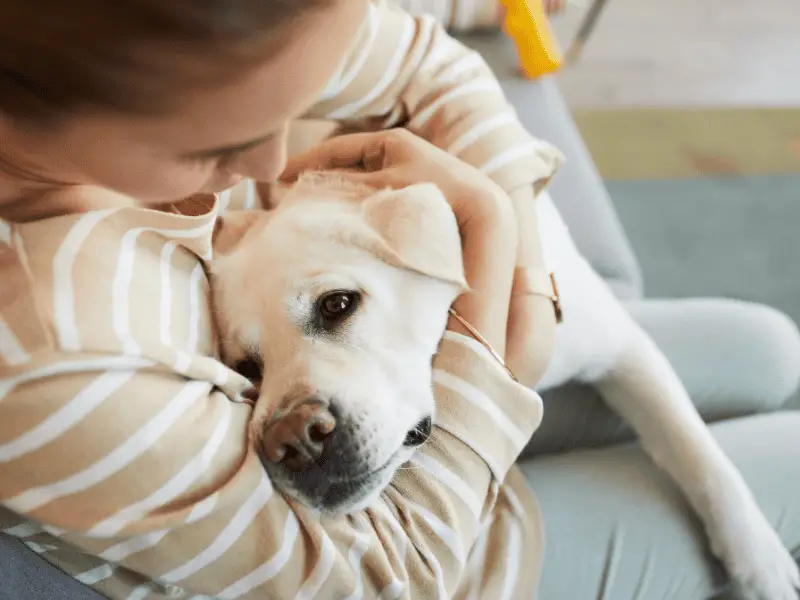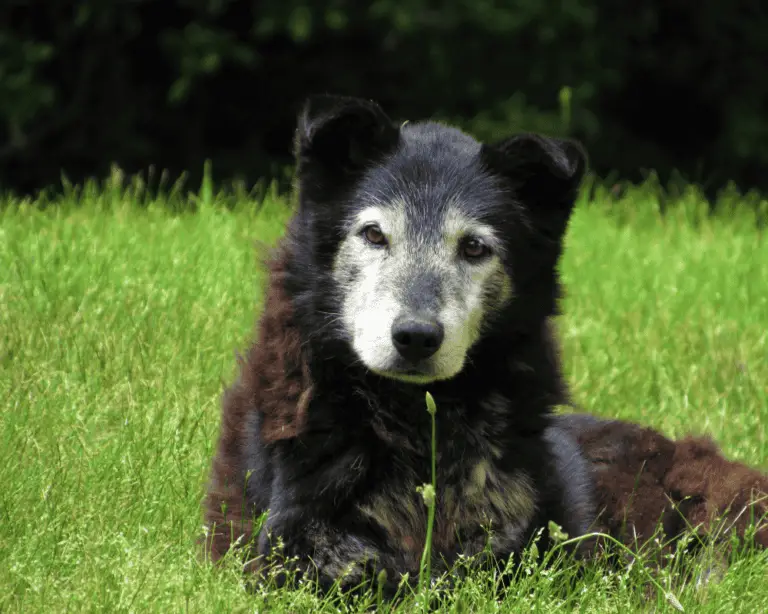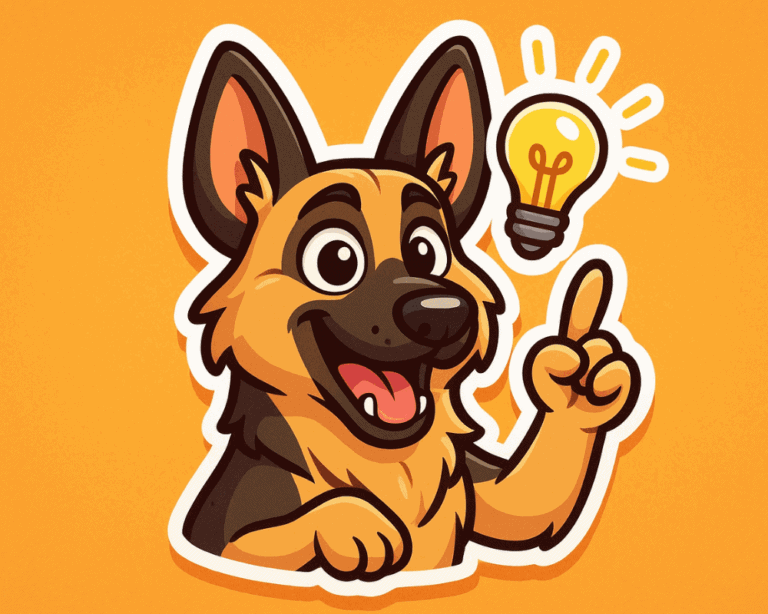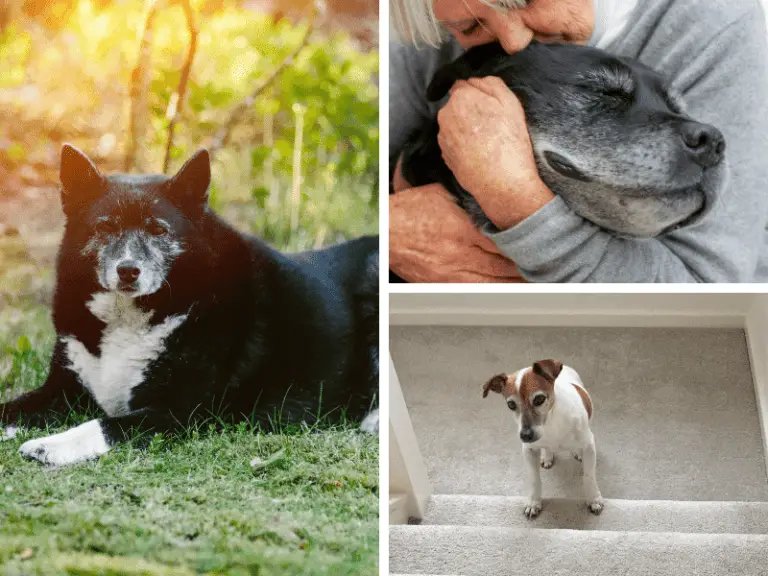On the Way to the Rainbow Bridge: Supporting Your Dog in Their Final Hours

Death is a part of life. As a dog lover, you’ll probably have to face this goodbye more than once in your lifetime. Fortunately, there’s an encouraging trend: our household dogs are living longer lives these days.
Since the 1950s, canine life expectancy has roughly doubled, as you can read on Dr. Svenja Joswig’s website.
But sooner or later, the end will come. Today, I’ll explain how to recognize the last hours of your dog’s life and what responsibilities lie ahead for you. I’ll also discuss whether a dying dog says goodbye to their owner.
Recognizing the Dying Process: The Stages of Death
First, it’s important to know: not every dog passes through all three stages of dying. The natural dying process can look very different from one dog to another, and is influenced by many factors. At any point, your dog could experience a sudden, severe health issue—say, a heart attack—which might mean they pass away even in the very first stage.
So when we talk about these three phases, we’re describing how things happen in an “ideal” scenario. Every dog reacts differently, so there’s simply no exact guide, even if there are no complicating health factors.
⚱️ Phase 1
In the first stage, your dog stops eating and drinking. Their bowl stays full and even their favorite treats no longer interest them.
This is more common in older dogs. If they’re fighting off an infection, they’ll often refuse food for a while. At this point, refusing to eat doesn’t always mean the end is near.
That’s why it’s important to take your dog to the vet at the latest after 24 hours without eating or drinking. Lack of water can quickly become dangerous for your pup.
Don’t try to force-feed your dog food or water without consulting your vet first. If needed, your vet can give your dog an IV drip, so they’re properly hydrated for now.
This stage usually lasts between one and three days.
⚱️ Phase 2
After refusing food and water, a burst of physical activity often follows. In this second stage, your dog may want to move a lot. You might even find them pulling you along on the leash again, just like in the good old days. Don’t mistake this change for an improvement in their condition.
Even in this stage, your dog will almost certainly continue to turn away from food.
We don’t fully understand why dogs become so active right before they die. Some scientists believe this restlessness is a way for dogs to burn through remaining energy reserves that might otherwise delay dying.
If you ask me, I suspect it has to do with sensing that the end is near.
Your dog might not know exactly what’s coming, but they sense that something big is about to happen. They notice their body isn’t working like it used to, which creates stress.
If you’ve ever been really stressed, you know how hard it is to sit still. I think dogs go through something similar in this stage of dying.
Whether you agree with me or not, one thing is crucial: your dog should be allowed to move if they want to. Let them walk around if they feel up to it. Of course, keep a close eye on them so they don’t hurt themselves. But imposing bed rest wouldn’t be right at this point.
This stage, too, can last several days. There’s simply no way to predict its exact duration.
⚱️ Phase 3
The third and final stage is the hardest for you to witness. The dying dog now lies mostly motionless. Attempts to stand up usually end in failure. If there’s anything left in their bowels or bladder, they’ll likely release it where they lie.
Some dogs also experience seizures or vomiting during this stage. Don’t restrain your dog during a seizure and make sure vomit can drain away easily. These symptoms are linked to progressing organ failure. Sadly, this is part of the natural dying process.
This video shows a dog in this phase of dying.
WARNING: Please only watch it if you’re sure you can handle it. The female dog in the video is vocalizing and having seizures.
The most difficult part of this stage is hearing the vocalizations. Some dogs begin to howl or even scream. The sound breaks your heart, and of course, your first thought is that your dog must be in pain.
While researching this article, I came across many sources claiming these vocalizations aren’t caused by pain. Unfortunately, I couldn’t find concrete references for this. Honestly? I find it hard to believe myself.
My Thoughts on “Pain During the Dying Process”
Organ failure is always associated with pain. Why else do we give dying people the strongest painkillers we have? I firmly believe that a dying dog can indeed be in pain—sometimes even severe pain. Of course, it depends on which phase they’re in and when the pain occurs.
By the end of the third stage, the dog becomes unresponsive and slips into a coma. Once this happens, they no longer feel pain. Their breathing grows shallower, their heartbeat weaker, until, finally, it stops for the last time and your dog exhales deeply one final time.
When Do the Final Hours Begin?
Large breeds age faster. That’s the conclusion reached by Cornelia Kraus and fellow scientists. That’s why giant breeds often live only about half as long as toy breeds. This doesn’t change the length of the dying process, however.
Sadly, no one can say exactly how long the dying process will take. Each stage—including the third—can last several days. To monitor the progress closely, you’d need to keep checking their pulse and breathing. But even if your dog’s heart sometimes slows down significantly, the end might still take a while yet.
The only thing I can say is: once the third stage begins, the end isn’t far off. But whether your dog has only a few hours or even a couple of days left—no one can tell.
Do Dogs Say Goodbye to Their Owners?
Science, unfortunately, doesn’t have an answer for this yet. As far as we know, dogs don’t understand death. Yes, they grieve for a lost companion or human, but that can also happen with separation that doesn’t involve death. Truly saying goodbye would require a dog to understand both dying and its finality.
Still, we can observe changes in our dogs’ behavior as they near the end. Some become much more affectionate, cuddling constantly and sticking close to their owners. Others seek solitude and need to be alone.
Both are perfectly fine. In those moments, your dog knows what’s best for themself.
How You Can Help Your Dog in Their Final Hours
You understand what death means—so the difficult task of supporting your dog now falls to you. You can ease their path and help relieve their suffering. Here’s how, in the steps below.
🩺 Stay in Contact with Your Veterinarian
When the dying process starts, be sure to let your vet know right away. At any point, veterinary support might become necessary. Whether euthanasia is needed, or if pain medication is enough while you let nature take its course, really depends on the situation. Euthanasia may be the best option if:
- your dog becomes aggressive and won’t let anyone help,
- there’s a risk of death by suffocation due to collapsing lungs or constant vomiting,
- your dog is in intense pain that medications can’t alleviate, or
- the dying process has clearly begun and you don’t feel you can handle seeing your dog through possibly several more days.
🕯️ Ensure a Calm Environment with Soft Lighting
It’s easier for your dog if it’s quiet around them while they’re dying. Only allow other pets nearby under your supervision and separate them if they become a bother. Turn off the doorbell and your phone, and avoid having visitors at this time.
Bright lights may also bother your dog now. It doesn’t have to be dark, but avoid cold white or harsh lighting. If needed, drape a cloth over a lamp to soften the effect.
🧼 Keep Your Dog Clean
By the third stage, your dog has lost control of their bladder and bowels. Remove soiled blankets or towels promptly, and clean up messes on their body as needed.
Alternatively, you can use puppy pee pads or patient pads and change them as necessary.
There are a couple of reasons for cleanliness: First, it maintains your dog’s dignity. Second, lying in waste for prolonged periods can lead to painful infections—something your dog definitely doesn’t need right now.
🐶 Respect Your Dog’s Preferences
I know how hard this is. But if your dog makes it clear they want to be alone, respect that. You don’t need to leave the room entirely or close the door, but give them space if they ask for it. Stay nearby so you’re there if they need anything—just don’t crowd them.
On the other hand, if your dog craves closeness, be there. Talk to them, pet them, play some gentle music you’d usually listen to together. Let your dog sense that you’re there, that they’re safe in familiar surroundings, and that you’re looking after them.
⚱️ Conclusion
There’s no way to say exactly when a dog’s final hours will begin. Each dying phase can last several days. That means you’ll only know the time has come right before the very end.
We don’t really know if dogs say goodbye to their owners. It’s unlikely, since a true “goodbye” would require an understanding of death’s meaning. Still, many dog owners interpret their dog’s increased need for closeness in those last days as a farewell.
Frequently Asked Questions
How long does the final dying phase last in dogs?
The final phase can last anywhere from a few hours to several days. Unfortunately, there’s no way to know exactly in advance.
How do I know when it’s time to let my dog go?
If you notice your dog is struggling to breathe, in severe pain, or suddenly becomes aggressive, it may be best to consider euthanasia rather than allowing natural dying to continue.
How can I cope with the loss of my dog?
Losing a beloved, furry family member is painful, and it’s entirely natural to grieve for a long time. If you feel your loss is still overwhelming you weeks afterward, talk to friends, family, or even a therapist about how you’re feeling.






